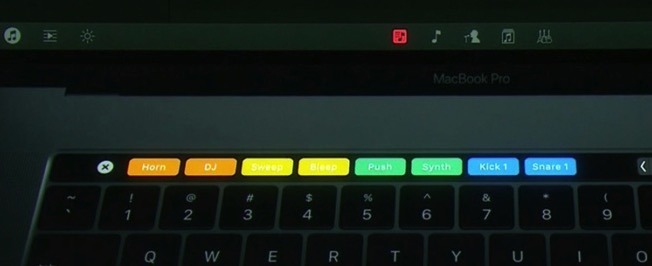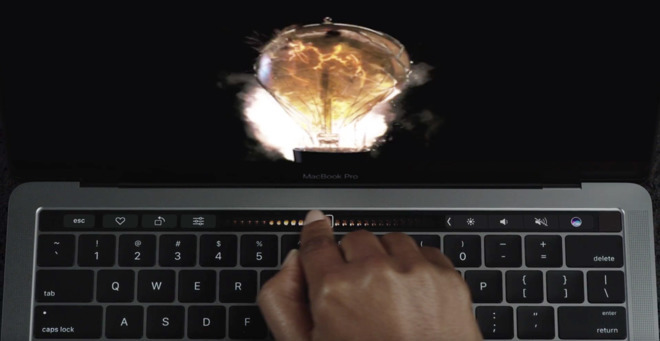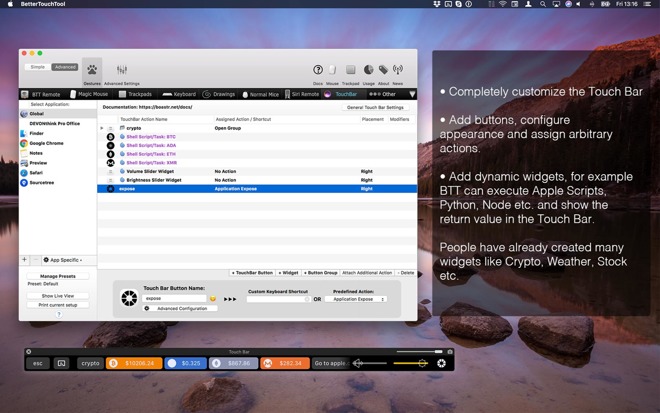The Touch Bar on the MacBook Pro is well implemented, but serves no useful purpose
With the 2016 MacBook Pro came polarization of the user base. It wasn't just over USB-C, but also Apple's new Touch Bar as well.

The old key functions aren't quite gone. If you hold down the FN key, the Touch Bar reverts to a standard strip of 12 function keys and the ESC key. If you boot into Windows, the Touch Bar reverts to displaying virtual FN keys.
After nearly 21 months of use, the verdict is still out on the Touch Bar here at AppleInsider. It's not a universal tool, and we don't use it for everything. Mileage may vary, user to user.
We said once that the the Touch Bar will take some time to mature and find its best uses. Out of the box, it hasn't really fulfilled its promise, but still has potential.
More on that potential in a bit.
Anything that can speed up workflow is a welcome addition. We gave Apple the benefit of the doubt and tried our best to incorporate the Touch Bar -- but it just didn't' stick.

Touch Bar use is literally limited to display brightness and volume adjustments. In Final Cut Pro, you have buttons to use as shortcut but none of them are new or innovative and each one of them can be accessed faster by using the keyboard. We did learn a few more shortcuts that we didn't know about previously, but we just looked up the keyboard commands for them.
The best video editing feature of the Touch Bar is seeing the video timeline and being able to scroll. But, for maximum efficiency and speed, you're better off sticking with the keyboard plus mouse or trackpad.
The Touch Bar has its uses for non-editors, but they are few and far between. Safari has a few niceties in Safari with open tabs, but given that you're looking at the screen to surf, this isn't the most convenient thing.
As we said talking about the 2017 MacBook Pro as a whole a year later, our Touch Bar use is generally limited to display brightness and volume adjustments. With some options, Touch Bar forces users navigate an extra menu to find certain settings, like adjusting the keyboard backlight and skipping audio tracks, tasks that take one simple keypress on standard function keys.
Some of these are Apple's user interface choices. Apple itself doesn't give users that much in the way of configuration options in this regard, but there is a way forward.
At a touch, Better Touch Tool can also run Apple Scripts, and return a value to the Touch Bar. So, there are already info-dense tools available for it, including weather and stock tools.

So, all those things that Apple didn't include for customization, Better Touch Tool can do.
There's a lot more that it can do, even for trackpad users. It's free to try out for 45 days, or it's included in a Setapp subscription.
There is another one we like called called 2Touch which isn't quite as robust, but leverages Apple's accessibility options to give the user a few more choices for the bar.
The Touch Bar could be great. It's got the ability to be great, as we've demonstrated. And, as we've said before, it has more to do with making the Mac easier for iOS users, than helping existing Mac users.
We can't help but feel that the Touch Bar is a transition to something else. While we'd prefer that tactile keys don't go away, between the short travel on Apple's Butterfly keyboard and the Touch Bar, we're starting to wonder if Apple wants to build a machine without a physical keyboard, and one with all virtual keys.
We'll see in the fullness of time, of course. But, like many other courses Apple has set, there's likely a destination on the horizon -- we just can't see what it is yet.
The Touch Bar's debut
The Touch Bar was intended to appear and function as a dynamic OLED strip of virtual keyboard keys, unconfined by the physical structure of mechanical keys. Optimally, all the keys are context-sensitive, changing not just appearance but size based on what app the user is in, and what the user is doing.
The old key functions aren't quite gone. If you hold down the FN key, the Touch Bar reverts to a standard strip of 12 function keys and the ESC key. If you boot into Windows, the Touch Bar reverts to displaying virtual FN keys.
After nearly 21 months of use, the verdict is still out on the Touch Bar here at AppleInsider. It's not a universal tool, and we don't use it for everything. Mileage may vary, user to user.
We said once that the the Touch Bar will take some time to mature and find its best uses. Out of the box, it hasn't really fulfilled its promise, but still has potential.
More on that potential in a bit.
Lacking as a video or audio editing tool
We do a lot of video work, as you can probably tell. The idea of a digital, customizable control panel that gives quick access to shortcuts was, and is, intriguing.Anything that can speed up workflow is a welcome addition. We gave Apple the benefit of the doubt and tried our best to incorporate the Touch Bar -- but it just didn't' stick.

Touch Bar use is literally limited to display brightness and volume adjustments. In Final Cut Pro, you have buttons to use as shortcut but none of them are new or innovative and each one of them can be accessed faster by using the keyboard. We did learn a few more shortcuts that we didn't know about previously, but we just looked up the keyboard commands for them.
The best video editing feature of the Touch Bar is seeing the video timeline and being able to scroll. But, for maximum efficiency and speed, you're better off sticking with the keyboard plus mouse or trackpad.
In general use
We don't have any complaints about the hardware at all. It is quick, and updates rapidly. The images are crisp and clear, and the touch sensitivity is second to none. It's just not that good in actual use.The Touch Bar has its uses for non-editors, but they are few and far between. Safari has a few niceties in Safari with open tabs, but given that you're looking at the screen to surf, this isn't the most convenient thing.
As we said talking about the 2017 MacBook Pro as a whole a year later, our Touch Bar use is generally limited to display brightness and volume adjustments. With some options, Touch Bar forces users navigate an extra menu to find certain settings, like adjusting the keyboard backlight and skipping audio tracks, tasks that take one simple keypress on standard function keys.
Some of these are Apple's user interface choices. Apple itself doesn't give users that much in the way of configuration options in this regard, but there is a way forward.
Third parties to the rescue!
Regarding potential, a third party app called Better Touch Tool allows users to completely customize the Touch Bar. In short, the bar can become a custom keyboard extension, with just about every parameter configurable for any given app.At a touch, Better Touch Tool can also run Apple Scripts, and return a value to the Touch Bar. So, there are already info-dense tools available for it, including weather and stock tools.

So, all those things that Apple didn't include for customization, Better Touch Tool can do.
There's a lot more that it can do, even for trackpad users. It's free to try out for 45 days, or it's included in a Setapp subscription.
There is another one we like called called 2Touch which isn't quite as robust, but leverages Apple's accessibility options to give the user a few more choices for the bar.
Probably not going away
We can't imagine a scenario where Apple decides to pull the Touch Bar. In all likelihood it will continue to offer a lower-end MacBook Pro with function keys, but won't make it optional across the line.The Touch Bar could be great. It's got the ability to be great, as we've demonstrated. And, as we've said before, it has more to do with making the Mac easier for iOS users, than helping existing Mac users.
We can't help but feel that the Touch Bar is a transition to something else. While we'd prefer that tactile keys don't go away, between the short travel on Apple's Butterfly keyboard and the Touch Bar, we're starting to wonder if Apple wants to build a machine without a physical keyboard, and one with all virtual keys.
We'll see in the fullness of time, of course. But, like many other courses Apple has set, there's likely a destination on the horizon -- we just can't see what it is yet.


Comments
The only downside is you lose the benefit of sliders, but that could be addressed by making the buttons longer than the old ‘fn’ keys.
Additionally, the trackpad has the potential of being its own display.
2) I assume Apple wants/wanted to get Touch Bar on wireless Apple keyaboards, but that may prove to be difficult since it runs off the T-series chip which I’ve read uses a fork of OS X built up from watchOS.
Then you have Apple Pay and Touch ID tied to it (which don’t have to carry over) but that do pose complexities in security.
Then you have power and bandwidth issues with having a wireless display in a keyboard. All of this is doable, but at what cost? Are users willing to pay, say, $250 for a wireless keyboard to get the Touch Bar when so many Apple userson this forum complain constantly about its existence?
But I'm nursing my 2013 MBA waiting for a MBP I could love, not one crippled by marketing decisions (Thin! Thin! Thin! No Touchscreen Ever! No matter what! Don't you really want an iPad Pro instead? [NO!] ). And so this sentence near the end crushed me:
"...we're starting to wonder if Apple wants to build a machine without a physical keyboard, and one with all virtual keys."
I really, really don't want to go back to Windows and its learning curve and replacing Mac only ways of doing things. But I feel I'm being pushed in that direction hard.
I think it's not us in the reality distortion field, rather, Apple management themselves. In so many ways they're killing the Mac line via the few design parameters they're allowing to rule.
To move forward with computing we need to move past the notion that productivity and power comes from the traditional desktop operating system UI.
I’ve done serious work on the iPad since the first version. For instance, using Pages on iOS for 95% of my post-graduate thesis (which, by the way, received a special mention for the quality of its presentation). Obviously you can’t do everything on the iPad, but you also can’t do everything on macOS that you can do on iOS—it simply depends on what you’re trying to accomplish.
The truth about the touchbar though is that it was designed with the assumption that most people are touch-typists ... and that is SO not the case.
It's not that there's no useful features of the Touch Bar, it's just that most of the features are more gimmicks than anything else.
Sure, introduce a new feature like the touchbar, and then fully integrate it through the OS and Apple apps to show its potential power. that is what Apple is famous for. Before release, work closely with major developers so at launch, you can show its power. And I don’t just mean substitute, customisable keys. A capability that wows everyone and makes competitors want to copy it.
Because at the moment, the biggest add ons it really does is make an MBP more expensive with a shorter battery life. There needs to be something amazing for the touchbar to do to justify its existence.
Edit: Back in the day I suspect at the Board presentation of the new machine Steve Jobs would have done what he famously did when the soon to be released Segway was shown off to him. Rip it to shreds and told them to think about the real world use case.